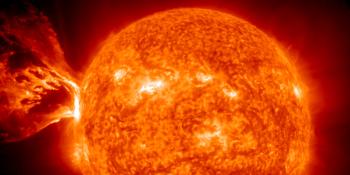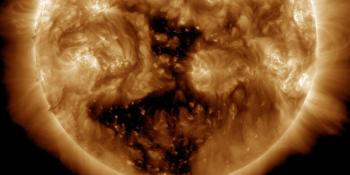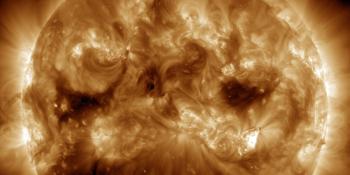Viewing archive of Thursday, 1 October 2015
Daily bulletin on solar and geomagnetic activity from the SIDC
Issued: 2015 Oct 01 1230 UTC
SIDC Forecast
Solar flares
C-class flares expected, (probability >=50%)
Geomagnetism
Active conditions expected (A>=20 or K=4)
Solar protons
Warning condition (activity levels expected to increase, but no numeric forecast given)
| 10cm flux | Ap | |
|---|---|---|
| 01 Oct 2015 | 120 | 011 |
| 02 Oct 2015 | 110 | 011 |
| 03 Oct 2015 | 110 | 006 |
Bulletin
Solar flaring activity is gradually decreasing, with only one M1 (with peak at 13:20 UT) and eight C-class flares, mainly from NOAA active region 2422. NOAA 2422 is slightly decaying but still retains a complex magnetic configuration. NOAA 2427 has slightly grown, but did produce much activity. A series of CMEs were launched on September 30 of which at least two were related to a prominence eruption at the southwest limb. SDO/AIA and PROBA2/SWAP data indicate that solar material starts to lift late September 29/early morning September 30 and part of it falls back south and another part falls to the north. The southern part produces a CME with first measurement in LASCO/C2 at 10:00 UT and shortly after that the NW part produces a CME as well. These two CMEs visually merge later on. They mainly propagate to the West with a speed of 330 km/s (CACTus estimate), but it is not excluded that a glancing arrives at Earth late October 4. The CME activity did cause a rise in the proton flux (at >10MeV) to about 1pfu, though the flux values have not reached the event threshold. Proton flux values are gradually decreasing again. More C-class flares are expected, with a 25% chance for M-class flares.
The slow wind speed was low (with values around 300 km/s) till around 11 UT when the speed slightly increased to about 330 km/s. The phi angle has been varying from negative (towards) to positive (away) orientation. At 11 UT, the interplanetary magnetic field magnitude reached a peak of 10 nT. The geomagnetic conditions are quiet (K<3) to unsettled (K=3) and are mainly expected to remain so. There is a some chance for isolated time slots of active conditions (K=4).
Today's estimated international sunspot number (ISN): 092, based on 20 stations.Solar indices for 30 Sep 2015
| Wolf number Catania | /// |
| 10cm solar flux | 131 |
| AK Chambon La Forêt | 006 |
| AK Wingst | 003 |
| Estimated Ap | 002 |
| Estimated international sunspot number | /// - Based on /// stations |
Noticeable events summary
| Day | Begin | Max | End | Loc | Strength | OP | 10cm | Catania/NOAA | Radio burst types |
|---|---|---|---|---|---|---|---|---|---|
| 30 | 1318 | 1320 | 1321 | S23W59 | M1.1 | 1N | --/2422 |
Provided by the Solar Influences Data analysis Center© - SIDC - Processed by SpaceWeatherLive
All times in UTC
Current data suggests there is a moderate possibility for aurora to appear at the following high latitude regions in the near future
ReykjavikCurrent data suggests there is a slight possibility for aurora to appear at the following high latitude regions in the near future
TórshavnOulu, Rovaniemi
Trondheim
Kiruna, Luleå, Sundsvall, Umeå
Latest news
Latest forum messages
Support SpaceWeatherLive.com!
A lot of people come to SpaceWeatherLive to follow the Sun's activity or if there is aurora to be seen, but with more traffic comes higher server costs. Consider a donation if you enjoy SpaceWeatherLive so we can keep the website online!

Latest alerts
Thursday, 10 April 2025
23:00 UTC - Geomagnetic activity
Active geomagnetic conditions (Kp4) Threshold Reached: 22:47 UTC
20:45 UTC - Hemispheric Power Index
The OVATION model predicts the Hemispheric Power Index to reach 50GW at 21:37 UTC
01:45 UTC - Geomagnetic activity
Active geomagnetic conditions (Kp4) Threshold Reached: 01:41 UTC
Wednesday, 9 April 2025
08:12 UTC - Hemispheric Power Index
The OVATION model predicts the Hemispheric Power Index to reach 76GW at 08:57 UTC
02:00 UTC - Geomagnetic activity
Minor G1 geomagnetic storm (Kp5) Threshold Reached: 01:45 UTC
Space weather facts
| Last X-flare | 2025/03/28 | X1.1 |
| Last M-flare | 2025/04/08 | M1.5 |
| Last geomagnetic storm | 2025/04/06 | Kp5 (G1) |
| Spotless days | |
|---|---|
| Last spotless day | 2022/06/08 |
| Monthly mean Sunspot Number | |
|---|---|
| March 2025 | 134.2 -20.4 |
| April 2025 | 144.7 +10.5 |
| Last 30 days | 138.8 +1.3 |





